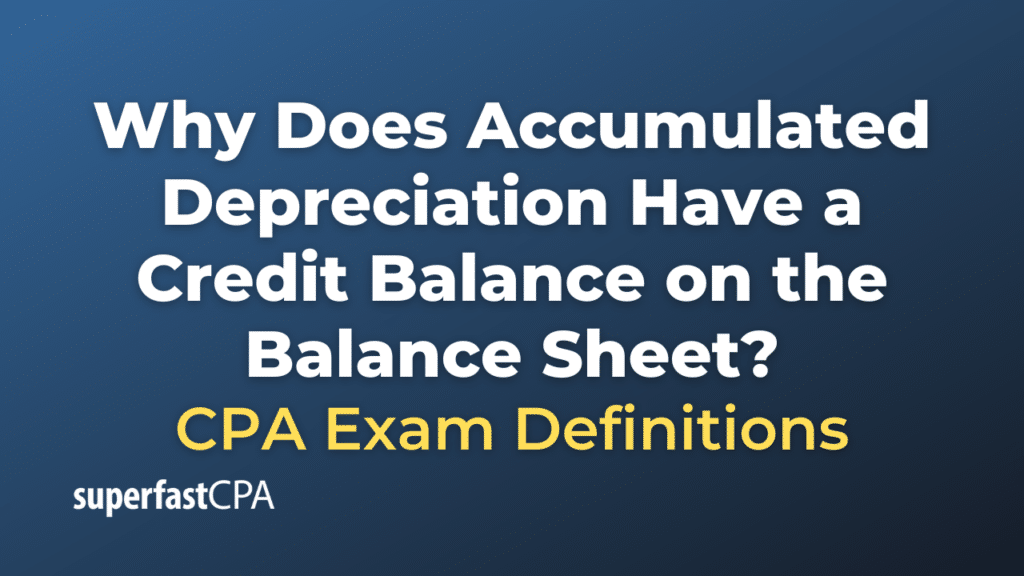Why Does Accumulated Depreciation Have a Credit Balance on the Balance Sheet
Accumulated depreciation is an accounting concept that represents the total amount of an asset’s cost that has been depreciated (i.e., expensed) over time. It is a contra asset account, meaning it is paired with an asset account but has the opposite balance. While assets usually have debit balances, contra asset accounts like accumulated depreciation have credit balances.
Here’s why accumulated depreciation has a credit balance on the balance sheet:
Accounting Mechanics:
- Initial Purchase: When a long-term asset like machinery is purchased, it is recorded as a debit in the asset account to increase its balance.
- Debit: Machinery $10,000
- Credit: Cash $10,000
- Depreciation Expense: Over time, the asset loses value due to wear and tear, age, or obsolescence. This loss in value is recorded as depreciation expense, which is debited to increase the expense, and accumulated depreciation is credited to increase its credit balance.
- Debit: Depreciation Expense $1,000
- Credit: Accumulated Depreciation $1,000
Impact on Balance Sheet:
- Asset Account: The original cost of the machinery remains at $10,000 (debit balance).
- Accumulated Depreciation: After one year, let’s say the accumulated depreciation account has a credit balance of $1,000.
These are represented on the balance sheet as:
- Machinery: $10,000
- Less: Accumulated Depreciation: $1,000
- Net Book Value: $9,000
Purpose:
- Reflects Asset Value: The credit balance in accumulated depreciation, when subtracted from the asset’s original cost, gives the net book value or carrying amount, which is a more accurate representation of the asset’s current value.
- Non-cash Adjustment: It allows for depreciation expense to be recognized in the income statement without affecting cash flow. Accumulated depreciation accumulates over time, reducing the book value of assets in a systematic manner.
- Tax Implications: Depreciation is a non-cash expense that reduces taxable income, providing tax benefits to the company.
- Capital Maintenance: It helps in capital maintenance by setting aside the depreciated value for asset replacement in the future.
So, the credit balance in accumulated depreciation serves multiple purposes, including reflecting the asset’s current value, aiding in capital maintenance, and offering tax benefits.
Example of Why Does Accumulated Depreciation Have a Credit Balance on the Balance Sheet
Let’s consider a simple example to illustrate how accumulated depreciation works in accounting.
ABC Company buys a delivery truck for $50,000. The truck has an estimated useful life of 5 years and a residual value of $10,000. The company uses the straight-line method of depreciation.
Year 1
- Initial Purchase: ABC Company buys the delivery truck.
- Debit: Delivery Truck (Asset) $50,000
- Credit: Cash $50,000
- Depreciation for Year 1: The annual depreciation is calculated as $50,000−$10,0005=$8,0005$50,000−$10,000=$8,000.
- Debit: Depreciation Expense $8,000
- Credit: Accumulated Depreciation $8,000
Balance Sheet at the End of Year 1:
- Delivery Truck (Asset): $50,000
- Less: Accumulated Depreciation: $8,000
- Net Book Value: $42,000
Year 2
- Depreciation for Year 2: Another $8,000 of depreciation is recorded.
- Debit: Depreciation Expense $8,000
- Credit: Accumulated Depreciation $8,000
- Updated Accumulated Depreciation: The accumulated depreciation account now has a credit balance of $16,000 ($8,000 from Year 1 + $8,000 from Year 2).
Balance Sheet at the End of Year 2:
- Delivery Truck (Asset): $50,000
- Less: Accumulated Depreciation: $16,000
- Net Book Value: $34,000
As you can see, the accumulated depreciation account has a credit balance that increases over time. This is subtracted from the asset’s original cost to give you the net book value, which more accurately reflects the current value of the asset.
This example illustrates how accumulated depreciation works and why it has a credit balance on the balance sheet. The credit balance serves to reduce the book value of the asset over time, reflecting its depreciation or loss of value.













